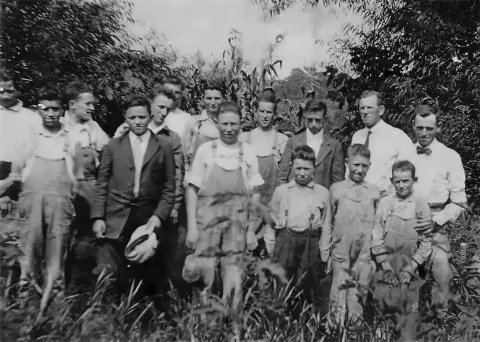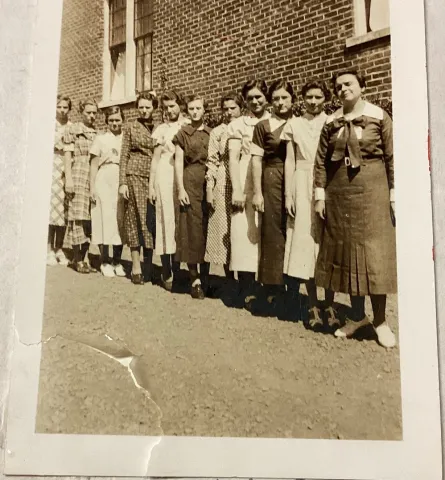The Beginning of 4-H

The first 4-H Clubs, referred to then as Corn Clubs, were organized by J. W. Kyker in 1918. Twenty-four boys enrolled in the project, eleven completed records. The eleven completing records were Charles & Tommy Ousley, Elmer Dunn, Raymond Monroe, Ralph & Roy Tarver, Lowell Stooksbury, Glen Irwin, Sherman Mitchell, Plumer Loy and Ted Sharp. The Corn Club winner was Lowell Stooksbury, who produced over 80 bushels of corn per acre at a cost of 14.6 cents per bushel. He grew Tennessee Red Cob. The picture was taken on the M.C. Dunn farm south of Maynardville. Other boys in the picture include Roy Acuff (front row left) Tad McDonald and Lillard Wallace. J.W. Kyker, Union County's Emergency Demonstration Agent, is in the back row on the right. Clay Patrick is in the front row on right.
J.W. Kyker, the first UT Extension Agent in Union County in 1918, found it difficult to get the local farmers to come together to better educate themselves at new farming techniques, presented by the University of Tennessee’s Agricultural Department. So he began to target the next generation by starting the first Union County 4-H Boys Club. He enrolled twenty five boys, using them to educate the adults. The first clubs were known as “Corn Clubs”. Note there is a photo of this group inside the Union County Extension Office. You may notice the legendary Roy Acuff was in this photograph. Retired Agent Bill Morgan told me that he had talked to Retired Agent Harold Julian about him being in the photo, Julian said that Acuff wasn’t one of the Corn Club members, but was with them and wanted to be in the photograph.
In 1918 the Spanish Flu Epidemic struck. The flu epidemic killed more people than any other illness in history at that time. Extension Agents were put to work by forming emergency hospitals and kitchens to prepare hot meals (Broth) for the sick. They taught the women and girls how to nurse the sick. Doctors ordered Buttermilk as a remedy for the many patients there were. The Home Demonstration Club Members began collecting buttermilk day and night from local farms.
In 1919 the new Home Demonstration Agent Mabel Miller from the University of Tennessee began to form the first 4-H Girls Programs. They were called the “Tomato Clubs”. There were seven clubs: Maynardville, Sharps Chapel, Chesney, Lead Mine, Luttrell, Loyston and Paulette. The first project was to make red caps for the War Effort. She taught the girls sewing, health and gardening skills.
- Log in to post comments
